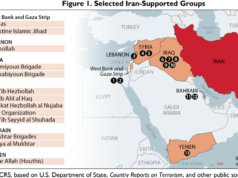While much has been made about the anti-American bias of Arabic-language television networks like al-Jazeera in recent years, policymakers have largely ignored the incitement and violent propaganda emanating from satellite television stations that are owned and operated by Middle East terrorist organizations, including Hamas and Hizbullah. These terrorist channels have played an important role in the radicalization of Europe’s Muslim populations. Yet, few steps have been taken to prevent these channels from disseminating jihadist propaganda.
Hizbullah’s Beacon of Hatred
Al-Manar (“the beacon” in Arabic) is Hizbullah’s communications arm. It is owned and operated by Hizbullah terrorists and financed by the Iranian regime. At its height, al-Manar reached an estimated 10 million to 15 million viewers per day, with around-the-clock coverage, thanks to an international network of 12 satellite providers and advertising sponsorship from multinational corporations.
Hizbullah established al-Manar in 1991 as an operational weapon to incite hatred and violence against both Israel and the United States. According to al-Manar officials interviewed by Avi Jorisch, the author of Beacon of Hatred (Washington Institute for Near East Policy, 2004), the station’s programming is meant to “help people on the way to committing … a suicide mission.” Viewers are told, for example, that the “path to becoming a priest in Islam is through jihad.”
Al-Manar is also virulently anti-Semitic. In one episode of al-Manar’s 29-part Ramadan special in 2003 entitled “al-Shatat” (the Diaspora), Hizbullah entertained its viewers with the Blood Libel. The series featured a rabbi who ordered his young son to kidnap a Christian friend so that they could slit his throat and use the blood for Passover matzos. The channel also features children’s programming that reinforces other anti-Semitic canards and glorifies suicide bombers.
Al-Manar, however, is not a mere propaganda tool. Hizbullah has used the channel to recruit suicide bombers, raise money for terrorist activities, and conduct surveillance for attacks. Indeed, al-Manar has incited attacks against Israeli civilians and American soldiers in Iraq.
Hizbullah-Israel War of 2006
Israel is keenly aware of al-Manar’s role in Hizbullah’s operational strategy. After Hizbullah launched its war against the Jewish state in the summer of 2006, the Israeli Air Force hammered al-Manar’s administrative offices in Beirut, as well as its broadcasting infrastructure in the Bekaa Valley, a Hizbullah stronghold. Concurrently, Israeli computer hackers disrupted the station’s service for a short time.
Hizbullah, however, had a contingency plan. After quickly shifting its operations to secret underground broadcasting facilities (there were reports that it was broadcasting out of the Iranian embassy in Beirut), al-Manar was back on the air. As the war continued, many European and American mainstream media outlets used al-Manar propaganda footage in their news broadcasts. In Lebanon and across the Middle East, viewers were glued to their sets as al-Manar lionized Hizbullah’s defiant Secretary General Hassan Nasrallah. The channel was largely responsible for the popular perception in the Arab world that Hizbullah achieved victory against Israel, even as Beirut smoldered.
Europe’s Response
In March 2006, the U.S. Treasury Department designated al-Manar as a Specially Designated Global Terrorist entity (SDGT), placing the television channel on the same terrorism list as al Qaeda, Hamas, and, of course, Hizbullah. Treasury highlighted the role of al-Manar in actively recruiting and fundraising for Hizbullah, and providing pre-attack surveillance for terror attacks. Undersecretary of the Treasury Stuart Levey observed that al-Manar is an “entity maintained by a terrorist group” and is therefore “as culpable as the terrorist group itself.”
Across the Atlantic, Europe has tried to follow suit. In 2005, the European Union and the governments of France, Spain, and Holland determined that al-Manar violated European law, specifically the prohibition of incitement to hatred in broadcasting under the European Union’s Television without Frontiers directive. These decisions encouraged four European satellite providers—two French, one Spanish, and one Dutch—to discontinue transmission of the station. Coca-Cola, Pepsi, Procter & Gamble, and Western Union were among the other well-known multinational corporations that discontinued almost $2 million in annual corporate advertising on al-Manar in 2002, after Jorisch exposed their support for Hizbullah television in the Los Angeles Times.
Thanks to two satellite providers, the Arab League-owned Arabsat, majority-owned by the Saudi government, and the Egyptian government-owned Nilesat, al-Manar continues to broadcast messages of incitement and violence to Europe’s Muslim population. During the 2006 Danish cartoon controversy, for example, Nasrallah repeatedly urged al-Manar’s viewers “to take a decisive stand.” He proclaimed that, “hundreds of millions of Muslims are ready and willing to sacrifice their lives in order to defend the honor of their Prophet. And you are among them.”
Al-Manar has become alarmingly popular among Europe’s Muslims—particularly young Arabic speakers. These disaffected Arabs in the restive suburbs of London, Paris, Madrid, Brussels, and Berlin continue to freely access Hizbullah’s messages of hate and incitement. On one German television program, young Muslims in Berlin explained that their hatred of the U.S. and Jews stemmed, in part, from al-Manar.
As of this writing, no further steps have been taken to halt al-Manar in Europe. Officials throughout Europe complain of the drastic rise of extremism among Europe’s Muslims, but have yet to take further measures to ban one of its primary communication vehicles.
Hamas’ ‘Dome of the Rock’ in the Sky
The success and popularity of al-Manar appears to have encouraged the Palestinian terrorist group Hamas to take its own brand of jihad to the airwaves. In autumn 2006, Hamas’ al-Aqsa television, previously aired only in the Gaza Strip, began to disseminate its violent message broadcasting via the same Saudi and Egyptian satellites as al-Manar, reaching Europe, the Middle East, and North Africa.
Founded in 2006, al-Aqsa TV routinely broadcasts Hamas leaders calling for jihad, songs of incitement to murder, and videos of Hamas gunmen. Al-Aqsa programs typically feature stories glorifying the actions of “martyrs” and assurances that, through their sacrifices, the “Zionist Entity” will be destroyed. As a supplement to Hamas’ print, radio, and online media, this television channel is an integral part of Hamas’ global strategy of subverting the peace process, raising funds for future attacks, disseminating propaganda in the Palestinian territories and the Diaspora, inculcating terror among children, and recruiting suicide bombers for future attacks against the Jewish state.
As is the case with al-Manar, Hamas TV also seeks to reach out to children and pre-teens. The channel recently made headlines for using characters similar to Disney’s Mickey Mouse and Simba, from the popular children’s movie The Lion King, to glorify suicide bombing in children’s programs. Faced with near-universal outcry, including from the Disney Company, the show’s producers killed off the Mickey Mouse character (they told kids that Israel killed the popular rodent) and found another mascot to tout the virtues of jihad.
Hamas TV Under Fire
After the June 2007 Palestinian civil war in which Hamas conquered the Gaza Strip, al-Aqsa TV came under fire from its political rival in the West Bank, the Palestinian Authority. In September 2007, Mohammad Eshtewy, director of the al-Aqsa satellite station in the West Bank, confirmed that the Palestinian Authority’s Intelligence Services had shut down the station and barred its activities in the West Bank because it “broadcasts and practices incitement.” The International Middle East Media Centre confirmed that the P.A. security services warned Mr. Eshtewy that they would arrest and prosecute any active employees if the station’s broadcasting was not terminated.
While these reports out of the West Bank are encouraging, al-Aqsa TV will almost certainly continue to air its programming from alternate studios in the Gaza Strip, where Hamas is now firmly in control. Moreover, thanks to Arabsat and Nilesat, Hamas will continue to broadcast into Europe where it will poison the minds of a new generation of European Muslims who are increasingly susceptible to jihadist messages.
Europe’s Stymied Efforts
Efforts to convince Egypt and Saudi Arabia to halt the transmission of Hizbullah and Hamas television programming by Arabsat and Nilesat have, until now, been rebuffed. This includes numerous entreaties from U.S. and European government officials. It is surprising that these Sunni countries refuse to cooperate, given their fear of the Islamic Republic of Iran, which uses both Hizbullah and Hamas as its regional clients to spread Shi’ite radicalism in the Levant.
For now, the European Union claims to be powerless to stop the broadcasts. The E.U.’s Television without Frontiers directive only applies to satellite stations broadcasting from within the E.U., leaving the Saudi and Egyptian satellites outside of the law, while national authorities have refused to take any legal action against these foreign broadcasters to date.
What Europe Should Do — But Won’t
Europe should continue to engage the Saudis and Egyptians to halt the broadcasting of both al-Manar and al-Aqsa TV and, failing that, enact legislation or launch suits against these satellite providers. But, if Riyadh and Cairo are not willing to act, and legal action proves ineffective, the West should consider limited military action against these terrorist stations.
While this may seem like an extreme strategy, military action against an enemy’s media assets is not without precedent. During the war in Kosovo, NATO planes bombed the Belgrade-based headquarters of Radio Television of Serbia. While 16 employees were killed, NATO justified the action as a legitimate attack against Serbian broadcasting of Milosevic’s violent call to arms against Kosovo’s Muslims. The question is whether European nations view Hizbullah or Hamas as a danger to their own security.
Should our European allies not have the stomach for military action, and it’s doubtful they would, they might also consider prosecuting individuals associated with the two terrorist television stations for war crimes. There is precedent for this, too. European states prosecuted hate speech as a war crime, first at the Nuremberg trials against Nazi officials after World War II, and then again at a special international court in Tanzania in 2003, when three Rwandan media executives were convicted, two of running a radio station and one of publishing a newspaper, calling for the systematic extermination of Rwanda’s Tutsis.
What’s at Stake?
Europe, in all likelihood, will not force Egypt and Saudi Arabia to stop airing al-Manar and al-Aqsa TV. Nor will Europe attack the channels or even try their executives for war crimes. But, as the ideology of radical Islam continues to spread unabated across Europe, our transatlantic allies must acknowledge that these terrorist channels are not merely crossing the lines of free speech. They are actively recruiting and fundraising for their clients in Tehran, and providing pre-attack surveillance for terror attacks. Failure to properly address this problem will only create more challenges for Europe as it struggles to get its mounting Islamist threat under control.
Mark Dubowitz is chief operating officer of the Foundation for Defense of Democracies and co-director of FDD’s Coalition Against Terrorist Media. Jonathan Snow of FDD and Roberta Bonazzi and Alexander Ritzmann of the Brussels-based European Foundation for Democracy collaborated with him on previous work dealing with this subject.





